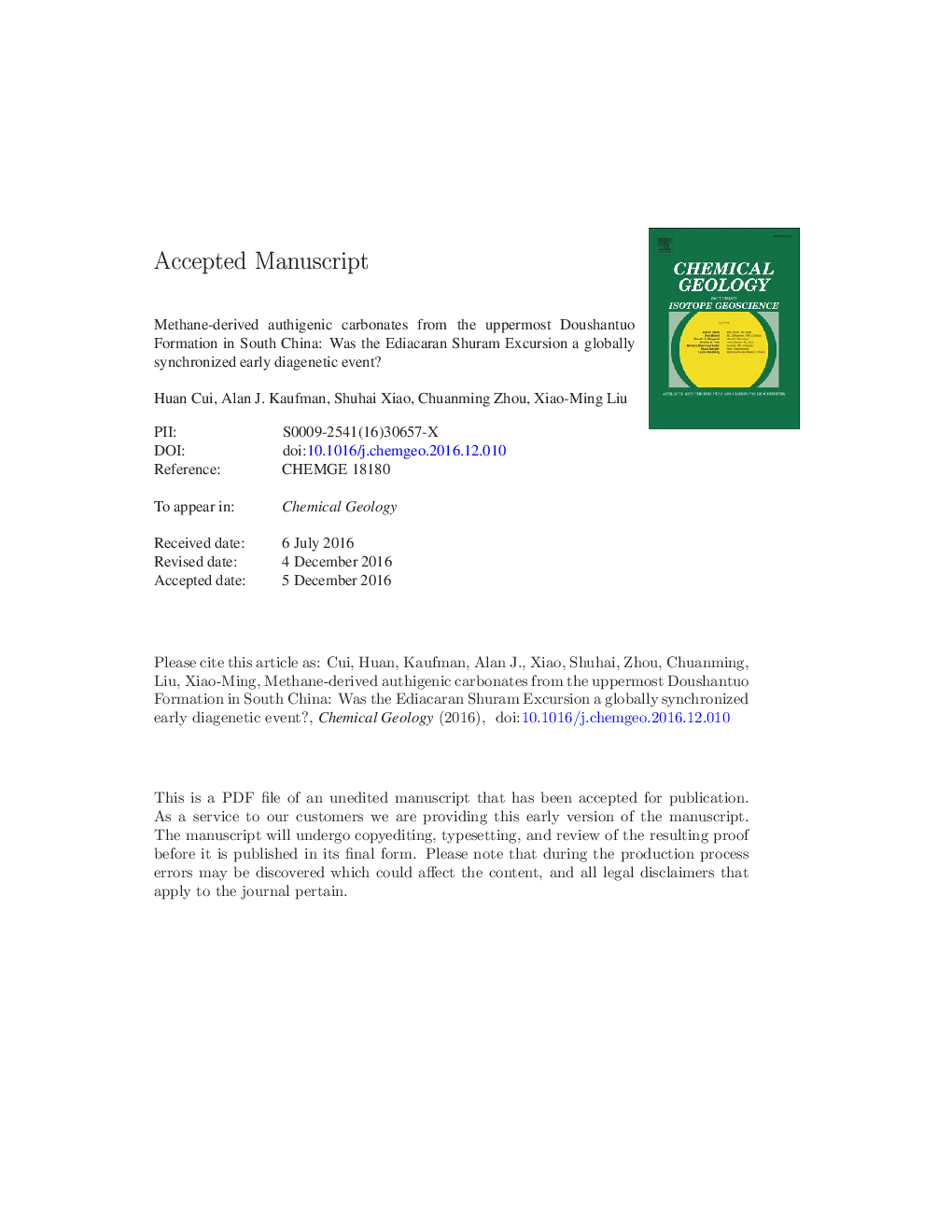| کد مقاله | کد نشریه | سال انتشار | مقاله انگلیسی | نسخه تمام متن |
|---|---|---|---|---|
| 5783058 | 1637524 | 2017 | 64 صفحه PDF | دانلود رایگان |
عنوان انگلیسی مقاله ISI
Was the Ediacaran Shuram Excursion a globally synchronized early diagenetic event? Insights from methane-derived authigenic carbonates in the uppermost Doushantuo Formation, South China
دانلود مقاله + سفارش ترجمه
دانلود مقاله ISI انگلیسی
رایگان برای ایرانیان
کلمات کلیدی
موضوعات مرتبط
مهندسی و علوم پایه
علوم زمین و سیارات
ژئوشیمی و پترولوژی
پیش نمایش صفحه اول مقاله

چکیده انگلیسی
The Ediacaran Period is characterized by the most profound negative carbon isotope (δ13C) excursion in Earth history, the Shuram Excursion. Various hypotheses - including the massive oxidation of dissolved organic carbon (DOC) in the oceans, the weathering of terrestrial organic carbon, or the release and oxidation of methane hydrates and/or expelled petroleum from the subsurface - have been proposed as sources of the 13C-depleted carbon. More recently, it has been suggested that global-scale precipitation of early authigenic carbonates, driven by anaerobic microbial metabolism in unconsolidated sediments, may have caused the Shuram Excursion, but empirical evidence is lacking. Here we present a comprehensive analysis of a Shuram-associated interval from the uppermost Doushantuo Formation in South China. Our study reveals petrographic evidence of methane-derived authigenic calcite (formed as early diagenetic cements and nodules) that are remarkably depleted in 13C - suggesting a buildup of alkalinity in pore fluids through the anaerobic oxidation of methane (AOM) - and systematically depleted in 18O relative to co-occurring dolomite. Early authigenesis of these minerals is likely to be driven by increased microbial sulfate reduction, triggered by enhanced continental weathering in the context of a marked rise in atmospheric oxygen levels. In light of the finding of methane-derived authigenic carbonates at Zhongling, and based on our basin-scale stratigraphic correlation, we hypothesize that the marked 13C and 18O depletion (including their co-variation noted worldwide) in the Shuram Excursion may reflect an episode of authigenesis occurring within a sulfate-methane transition zone (SMTZ). If true, the Shuram Excursion was then a global biogeochemical response to enhanced seawater sulfate concentration in the Ediacaran ocean driven by the Neoproterozoic oxidation of surface environments. This paleo-oceanographic transition may have therefore paved the way for subsequent evolution and diversification of animals. Our study highlights the significance of an integrated approach that combines petrography, mineralogy, and texture-specific micro-drilling geochemistry in chemostratigraphic studies.
ناشر
Database: Elsevier - ScienceDirect (ساینس دایرکت)
Journal: Chemical Geology - Volume 450, 5 February 2017, Pages 59-80
Journal: Chemical Geology - Volume 450, 5 February 2017, Pages 59-80
نویسندگان
Huan Cui, Alan J. Kaufman, Shuhai Xiao, Chuanming Zhou, Xiao-Ming Liu,